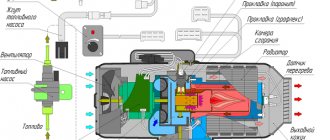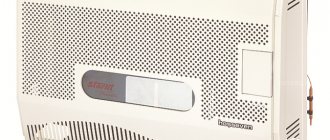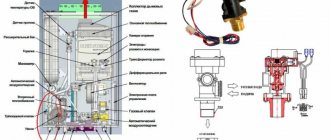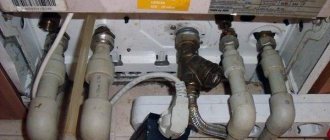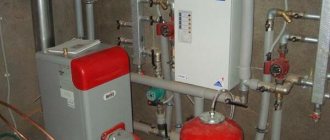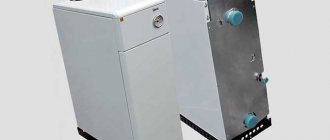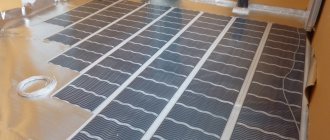In cold weather, the first instinct when getting into a car is to stay warm. At the same time, not only our body experiences discomfort, but also the mechanisms of the car itself.
In particular, at sub-zero temperatures, problems may arise with starting the power unit and warming it up. In both the first and second situations, an autonomous interior heater can help out.
What are the features of this device? What types of heaters are there? How do they work? Below we will look at each of the questions in detail.
What is an autonomous interior heater?
Autonomous interior heater is a device for heating the interior of a car. This “assistant” is in greatest demand among professional drivers, truckers and construction crews.
All car heaters are divided into the following types:
1. Air.
Devices designed to warm up the interior of a car (cargo compartment, car interior, luggage compartment, etc.).
These products work on the principle of a hair dryer. The air is passed through the heater, heated and supplied back.
Thanks to the presence of adjustment, the driver has the opportunity to economically spend battery charge and fuel resources.
The most popular manufacturers are Planar, Webasto, Belief and others.
The photo shows the Planar interior heater.
2. Liquid.
More functional devices that heat the engine first, and then the interior of the car. This feature makes it easier to start the vehicle in cold weather when the air temperature is below 0 degrees Celsius.
Such heaters can be controlled from a remote control point or programmed in advance for a specific time. Popular manufacturers of such devices are Binar, Webasto, Eberspacher.
It is worth noting that auxiliary interior heaters can operate from four different power sources:
- voltages - 12 and 24 Volts;
- gas (propane);
- gasoline;
- diesel fuel.
Combined options are also possible when the device requires power (12/24 Volts) and one type of fuel (gasoline/diesel).
Choosing equipment for a private home
There are times when home owners independently try to determine what equipment for air heating at home is needed for their heating system. Unfortunately, ignorance of certain rules and failure to comply with requirements leads to the purchase of insufficiently powerful equipment - and then the system does not work well.
Stationary gas heat generator
In order to select the most suitable heater model, you need to calculate such an indicator as the minimum power required for high-quality heating of the existing room. To determine the heat capacity of a room, you should use the formula
Р=VхΔTхk/860
In it, V (m3) is the nominal area of the building. ΔT (°C) – the difference between the temperature inside and outside the building. k is the building’s thermal insulation index. If it is unknown, this information can be obtained from a special reference book. 860 is the coefficient that converts kilocalories into kilowatts.
In what cases and on what vehicles are heaters used?
The task of autonomous interior heaters is to maintain optimal temperature in the cabin or luggage compartment.
Feature: operation without starting the power unit. The principle of operation is based on capturing air, warming it up and sending it back into the cabin.
The devices can operate in several modes - with air intake from outside or in standard ventilation mode.
The heater is started by an external thermostat or a built-in timer (programmed by the car owner).
Autonomous interior heaters provide a comfortable temperature for the work of different categories of motorists - operators of special equipment, truck drivers, truckers, and so on.
Any of these professions requires maximum attention and has an increased level of complexity. Full heating allows you to perform the assigned tasks efficiently.
In the CIS countries, the cold season lasts for 4-5 months, so the use of special heaters is very important.
These devices are installed in ambulances, truck cabins, vans with cargo sensitive to cold weather, and so on.
The heater will be useful in the interior of a minibus, in the compartments of truck drivers, in the cabins of construction and road special equipment.
High-quality and timely warming up eliminates the problem of driver freezing and prevents icing of the windows and control panel.
Frequently warming up the car while idling is ineffective and leads to excessive fuel consumption. That is why heating devices, distinguished by their autonomy, are so popular among car enthusiasts.
Characteristics of autonomous interior heaters:
- high-quality heating of the cabin even in severe frost;
- autonomy from the engine, fuel tank and battery (not relevant for all models);
- ease of use and reliability (no rotating elements, no electronic parts);
- fuel economy;
- no harmful emissions into the atmosphere.
Precautions for use
Any type of gas device requires regular cleaning and checking the equipment for possible fuel leaks.
Gas heaters should be used exclusively for their intended purpose.
Such devices should not be installed near flammable materials and objects, or without the need to remove the protective grille on the housing.
Equipment repairs are carried out only in specialized service centers. It is important to remember that the heat source can be propane or butane. The first option is most effective in winter, and the second allows you to create a comfortable temperature in the off-season or when heating non-residential premises.
Electric interior heaters for 12 and 24 V
Until recently, almost all electric interior heaters had a spiral design.
Today, most devices are made using ceramics.
The advantage of this product is its oxygen-saving properties, which allows you to maintain the air quality in the cabin and not “dry” the air.
The ceramic heat fan can be powered by 12 or 24 Volts, it quickly warms up and heats the room.
The main advantages are efficiency, protection against overheating and falls, compactness and lack of interference when driving.
Electric interior heaters are lightweight (up to 500-800 grams), which allows the product to be transported to any necessary place (to the garage, to a parking lot, and so on).
The only drawback for many of them is the high cost, but if you wish, you can choose a device that suits your own pocket. Here a lot depends on the manufacturer and power.
1. For passenger cars.
Autonomous heaters for this type of car are represented by a whole group of high-quality models.
Here are some of them:
- Calix Slim Line 800W is a very powerful device that can heat the interior of a compact car in a short time. The device is equipped with a switch that allows you to adjust the car to the current climatic conditions. The heater has thermal protection, which prevents erroneous operation (for example, when there is no air flow from the street). Calix Slim Line 800W is a high-quality heater with a high level of safety. Warranty - 3 years.
- ZNICH PFJ is a heater for the passenger car interior, operating on 12 and 24 Volts. The device is intended for passenger cars with a small interior. The advantages of the device include the ability to adjust the temperature, compactness, ease of installation, and durability.
2. For trucks.
Airtronic products are in great demand on the market of autonomous heaters for trucks.
Here we can highlight models D2-D5, which are distinguished by their unique power and are designed for heating various vehicles, from commercial vehicles to yachts.
The devices are powered by 12/24 Volts, are affordable and highly efficient.
Such heaters show high efficiency even with frequent door openings (for example, in public transport).
Ballu BOGH-15E
Country of origin: Russia. The infrared type model is designed for outdoor heating and lighting. The design has the shape of a vertical flask.
Suitable for installation in a barbecue area in the garden yard. A special feature of the model is the ability to adjust the height of the flame, which can be done manually or remotely using the control panel.
The heater body is made of alloy steel, which has increased resistance to corrosion. A tetrahedral reflector located on top of the structure serves as protection for the device from precipitation.
Its surface area is 0.5 square meters. m. The model has a multi-level protection system. When the flame is tilted more than 45 degrees, it is extinguished by thermoelectric sensors that shut off the gas supply. They also monitor possible gas leaks.
Expert opinion
Chebatkov Maxim Pavlovich
Specialist in household appliances and their repair
The mobile design easily moves on flat surfaces due to the built-in wheelbase. There is a slate magnetic surface at the bottom of the case. When placed on the summer terraces of cafes, you can place advertisements on it.
Specifications:
- gas consumption – 300-900 g/hour;
- maximum power – 13 kW.
Advantages:
- 100% fuel combustion;
- increased recoil of the glass flask;
- possibility of remote control;
- attractive appearance;
- several combustion intensity modes;
- mobility.
Main disadvantage:
- high price.
Gas heaters
Gas interior heaters differ from the “competitors” discussed above in their power source. In this case, the devices operate on liquefied gas.
The main advantages of the designs are ease of execution, safety in use, and complete independence from anything. With such a heater you don’t have to worry about the battery draining.
In addition, gas combustion products do not poison passengers, but are discharged into the street, which guarantees safety even for long-term use.
The principle of operation of the device is to circulate air flows in the car. Heat transfer occurs due to natural convection of air in the car.
For more active mixing, an additional low-power fan can be mounted in the cabin.
Gas autonomous heaters do not cause problems during operation; they have no rotating elements, which ensures maximum reliability and safety.
Structurally, the device is a system of coaxial pipes, when each of the subsequent pipes is located inside the other. One pipe carries clean air from the street, and the second pipe removes exhaust gases.
As a result, the air in the cabin is not used or burned out. All that remains is warmth.
The device does not depend on the performance of the car, so even if the engine breaks down or the battery is discharged in winter (even in an open field), you can turn on the device to enjoy the warmth.
The average lifespan of such devices is about 14 years.
Advantages of gas autonomous heaters:
- affordable price due to the lack of electronics in the device;
- the presence of a climate control system, which is found in most modern devices. At the same time, you can always set and maintain the optimal temperature;
- independence from vehicle resources, which guarantees performance in any conditions;
- the ability to power the device from cylinders of various capacities - 12 and 24 liters.
Basic operating rules:
- the heater can be turned on both when parked and while moving;
- to activate the device, just open the tap through which gas is supplied, turn on the device and start it;
- deactivation is carried out by triggering the corresponding toggle switch.
For example, a good option is SELENA PILOT-2 -E1. The heater requires only gas to operate.
Power - about 2 kW, heated area - up to 20 sq. meters. Thanks to this power, it can be used not only to heat the cabin, but also to warm up the space inside the body.
Gas autonomous heaters are used wherever autonomous heat is needed - in cars (trucks and cars), in the garage, when working on special equipment, and so on.
Advantages of the device
The undeniable advantage of gas heaters is the possibility of autonomous heating of premises for any purpose. Among other things, gas heating equipment falls into the category of the safest options, which is due to the slight heating of the housing and the lack of user contact with the heating element under conditions of proper operation.
According to experts, the main advantages include small dimensions and variety of design, which allows the installation of gas heaters in rooms characterized by a small area.
Properly selected equipment is easy to move and mobile.
Such devices are completely independent of the power grid and centralized gas pipeline.
Gas cylinders are refilled as needed.
The uniformity of fuel consumption allows you to obtain significant cost savings when using gas autonomous heating, even with an efficiency factor of 80%.
Gasoline auxiliary interior heaters
Webasto is a popular brand that offers a wide selection of quality heaters. One of them is Air Top.
The device comes with a control element and an installation kit.
The device is capable of quickly warming up sleeping areas and cabins even in large trucks (including those operating in harsh climates).
The use of ceramic technology minimizes the load on the battery.
Structurally, the device consists of:
- air intake systems;
- control unit;
- built-in temperature sensor;
- air blower motor;
- burners with evaporative gasket;
- heat exchanger;
- switch;
- fuel pump;
- timers and other nodes.
Design and functionality may vary depending on model.
The only thing that remains unchanged is the main fuel for work - gasoline.
Advantages of a gasoline auxiliary heater:
- high water resistance of parts and connections;
- fast air heating even in a large cabin;
- air capture not from the cabin, but from the street;
- low noise level;
- control using an automatic control unit;
- battery life - up to two hours;
- the presence of a temperature controller, alarm function, and so on.
Characteristics of one of the most popular models Air Top 200 ST:
- power - from one to two kilowatts;
- voltage - 12 Volts;
- gasoline consumption - 140-270 grams per hour;
- volume of incoming air - 78 cubic meters. meters;
- total weight - 2.6 kg.
Gasoline heaters are used:
- for heating cargo compartments when transporting certain goods;
- to normalize temperature in passenger transport;
- in construction, loading and road equipment;
- on yachts or ferries.
Types of heat generators
Today there are two types of gas heat generators - stationary and mobile. In turn, stationary heat generators also come in two types – suspended and floor-mounted.
Mobile air heating heat generators are used extremely rarely today. The reason is quite simple - they require gas in cylinders to operate.
And since it is not always possible to purchase a new cylinder, we can say that the system is not the most convenient. The use of mobile heat generators can only be caused by extreme necessity and for a short period of time.
Mobile gas heat generators
Stationary heat generators are more common. Suspended heat generators can be located both on the outside of the building and on the inside. Floor-mounted heat generators come in two types: horizontal, designed for heating buildings with low rooms, and vertical, intended for installation on the street and in the house.
Air heating systems
Diesel auxiliary interior heaters
Diesel heaters for cars have the same principle of operation as their gasoline “brothers”.
The only difference is the fuel used and the main characteristics. The most popular models include:
1. Belief FJH-5/1C.
Diesel autonomous heater with a power of up to 5 kW and an operating voltage of 12 Volts.
It is used for heating small buses, medium-sized yachts, compartments of trucks and rescue equipment.
Fuel consumption is from 190 to 600 grams per hour. The volume of heated air per hour is 200 cubic meters. m. (at maximum mode).
The main advantages are ease of use, functionality, the presence of an electronic control unit, durability and safety of operation.
The device comes complete with a mounting kit and a regulator. Country of origin: Hong Kong. Warranty - one year.
2. Webasto Air Top 5000.
Another popular device that runs on diesel fuel. The heater power is from one and a half to five kilowatts. Supply voltage - 12 or 24 Volts.
Total fuel costs (per hour) - from 180 to 600 grams. The volume of air blown is about 200 “cubes”. Weight - 5.9 kg.
Rules for safe use
A few words about the safety of household gas stoves. The main rule is to provide good, working ventilation.
To install any devices operating on propane-butane, it is necessary to establish stationary ventilation in the room or ensure constant access of air to the tent
Despite the manufacturer's assurances, the body of most models or the protective grille heats up during operation, so beware of burns and keep children and animals away from heating units.
In devices with three burners, ignition occurs in stages, so some of the gas may leak into the room - this can be easily determined by the specific smell. For this reason, the room or tent must be ventilated immediately after starting the heater.
To install household gas stoves, you do not need to insulate the floor or walls, but you need to ensure that flammable objects are nearby - some models have open flames.
Existing types
It is customary to classify autonomous heaters primarily by area of application:
- air - heats only the cabin air, representing a regular heat fan;
- liquid - connected to the engine cooling system and fuel system, heats the interior, door locks and windshield;
- oil - capable of heating the car’s oil system, which speeds up engine starting in winter.
In addition, heaters are distinguished by the type of power used: gas, electric, fuel (gasoline/diesel) and combined.
Gas
The basis of gas stoves is blue fuel. The main operating element is the fan, which ensures free air circulation. It heats up to the desired temperature during gas combustion, and additional blades are used to speed up heating.
Advantages of gas autonomous systems:
- They work even when the engine is stopped, without integration with other car systems, so the driver does not need to worry about draining the battery, and on the coldest days it will be very warm inside the car.
- Such devices do not contain electronic sensors or other complex mechanisms, which significantly increases their service life.
- They are completely harmless to people, because the gases that appear during combustion are immediately released outside.
- To ensure the operation of the device, it is only necessary to refill the gas in a timely manner. Considering the price of gasoline and diesel fuel, this heating method is financially beneficial.
As for the disadvantage of a gas autonomous heater, it is the impossibility of installation in the engine compartment. This type of “autonomy” only heats the interior of the car, but does not fit under the hood due to the peculiarities of its operation and dimensions.
Petrol
The gasoline heater is most often found under the Webasto Air Top nameplate. This is the highest quality of analogues. The Webast headset comes with a control system and mounting parts. “Avtonomka” is capable of warming up sleeping areas and cabins of trucks and passenger car interiors well, regardless of the temperature outside the window. Improved technology significantly reduces the load on the battery.
The design of the device includes the following elements:
- air intake;
- built-in heat regulator;
- Control block;
- air blower motor;
- thermocouple;
- evaporator;
- gasoline pump;
- toggle switch;
- automatic time controller.
Of course, technical specifications may vary depending on the model and manufacturer of these devices. The only common feature is the use of gasoline as a power source. The advantages of this type of “autonomy” are moisture resistance, noiselessness, and independent operation for up to 2 hours. Power: 1-2 kW.
Diesel
Diesel devices have the same features. Among the well-known ones we can name Webasto AIR TOP 5000. Heater performance reaches 5 kilowatts. “Avtonomka” consumes about 180-600 grams of fuel per hour of operation.
It is more advisable to use a combination of autonomous heaters, which will allow you to use all options. This will ensure 100% heating of the interior, easy engine starting and high comfort during use.
Table: technical characteristics of HYDRONIC B4W SC
| Coolant | Water, coolant |
| Heat flow regulation | High, small |
| Heat Flux (W) | 4300/1500 |
| Fuel consumption (l/h) | 0,2-0,6 |
| Average electrical consumption power (W) in operating mode | 22-48 |
| Average electrical consumption power (W) at startup | 120 |
| Rated voltage | 12 V |
| Permissible operating pressure | up to 2.5 Atm |
| Amount of water in the heating device | 0.18 l |
| Water pump capacity at 0.1 atm | 900 l/h ±100 l/h |
| Minimum water throughput of the heating device | 250 l/h |
| Permissible ambient temperature in operating mode | -40 °C to +80 °C |
| Weight - without coolant and mounting parts | 2.7 kg |
How to install and connect a fuel pump
Let's move on to connecting the fuel pump. Spray its fastening rubber with WD40 liquid (otherwise the barrel will not fit), and pull it onto the pump.
Where the fuel pump has a terminal block for the wires, this is the outlet to the heater.
On the other side, a tube from the diesel fuel tank is connected. Attach the fuel pump to the wall at an angle of 45 degrees or strictly vertically.
In this case, air will not accumulate in it and the liquid will completely fill the entire space.
In this case, it is advisable to place the pump itself below the diesel fuel tank, and the fuel hose should not have sharp turns.
This is done so that in the event of airing (for example, opening the lid to add diesel fuel or checking the level), air can easily escape from the tube upward into the tank. Otherwise, the pump will take a very long time to pump.
They say that this pump is one of the weakest elements of the system and is the first to “fly”. Fortunately, the Chinese sell them in unlimited quantities. You can select the right model for your Webasta here.
Fuel pumping
Before the very first start, it is necessary to pump the fuel. To do this, simultaneously press the two lower buttons - OK and down arrow.
The words “H” and “OF” will light up on your display.
Switch to ON.
After this, the pump starts in a jerky manner with clicks. The corresponding icon is displayed on the screen.
To turn off pumping, set everything to OF mode by pressing the down arrow. The first step when pumping is to fill the filter.
Eventually the liquid in the tube should reach the end of the fuel hose.
Pull it and clamp it with a clamp at the corresponding inlet into the stove.
Upon completion of pumping, we proceed to the first launch.
Setting up the control unit and connecting power
Let's move on to connecting the control unit and power wires. Attach the plastic display pad to a convenient place with screws.
At the top of the display is a sensor that measures the current temperature in the garage. Be careful not to damage it or cover it with anything.
Otherwise, you will not be able to get the device to work correctly. Connect the wires from the control box to the pump and heater through special contact chips. It's difficult to confuse them.
The thickest is the power wire, which must be connected either from a battery or from a 12V power supply.
Similar ones are widely used for LED strips. The current consumption of the Chinese Webasta heater at startup reaches 10A. Therefore, it is better to take a powerful unit with a reserve of 250-300W.
If you don’t want to buy a separate unit, then use a charger connected via the battery and the network.
This thing will never be useless in any garage. Is it possible to connect this Webast only from the power supply, without a battery? No, not recommended. It is advisable to use them in parallel connection.
Otherwise, if the light suddenly goes out, the heater will simply burn itself out from the inside. In normal mode, when you turn it off with the button, it first cools all its internals, extinguishes the flame, and only then completely and correctly turns off the fan and turns itself off.
Therefore, it is necessary to have a battery if you want the device to work for a long time and properly.
The main question that interests many is how long will the battery last? As real tests have shown, for a 90-amp battery, the heater lasts for 10-12 hours of continuous operation. Well, in general, roughly assume a maximum current of 10 A/h.
After applying voltage and pressing the power button, the display lights up.
What functions does it have, how to manage it? Press the "OK" button - the temperature is displayed.
Press “OK” again - the power set on the heater is displayed.
It can be reduced or increased using the up and down buttons on the right side.
Next comes the current voltage of the on-board network from the battery or power supply.
This is followed by error codes.
You can see what they mean from the table below.
After the codes, the time is displayed and all functions are repeated again.
Requirements for installation
To connect a gas heat generator for air heating at home, you need to carry out preparatory work and purchase:
- flexible air duct, which is a galvanized tube for circulating heated air;
- tees are needed to create an air line and connect pipes;
- for taking in cold air and supplying hot air - a grille;
- to seal the line connections - aluminum tape;
- mounting fasteners;
- knife.
You should first take care of the air duct.
You can install a gas heat generator with your own hands, but it must be connected to the gas pipeline by representatives of the gas service, with which an agreement has been concluded for the supply of blue fuel and maintenance of equipment
The ideal option is to design airways - channels at the construction stage of the building.
To install heating in a finished house, you need to erect false walls and suspended ceilings. Pipes will be disguised in the resulting niches.
Table: advantages and disadvantages of autonomous vehicles
| Advantages | Flaws |
| Autonomous mode, does not depend on external power sources. | Difficulty of installation. This is not an electric heater that you can easily install yourself. |
| Super-efficient and capable of long-term continuous operation. On cold winter days, the car interior and internal combustion engine can be heated to operating temperature with a fuel consumption of less than 1 l/h in just 40-50 minutes. | Expensive. Even basic models cost an order of magnitude higher, without additional components. In addition, the installation of such equipment is highly valued - at least 8-10 thousand rubles. And the more difficult it is to find a place under the hood for installation, the more expensive the installation will be. |
| Wide range of activation and programming options. | Some models are dependent on fuel quality. It is recommended to pay attention to this and regularly carry out diagnostics and cleaning. In addition, there is a dependence on the battery. You should always keep a charged and reliable battery under the hood. |
Step-by-step instructions for assembling a Chinese Webasto
How to assemble this heater and prepare it for operation? The first thing you need to think about is attaching a metal plate to the wall on which this stove will stand.
To do this, it is convenient to use small metal corners.
But with sufficiently thick walls, you can make a more reliable fastening with studs.
Next, before placing the stove on the plate, do not forget to thread the power cable through a special slot.
Screw the exhaust corrugated pipe with a clamp to the pipe, from the side of the hole with the aluminum radiator.
Those who have already tested this stove in operation suggest fitting the exhaust with a high-temperature sealant. A conventional clamp cannot always create such a tight connection that completely isolates the exhaust gases.
Here's a look at the results of operating such a stove without good exhaust sealing. Gases visibly escape.
When installed in a car and the pipe protruding on the street, this is not critical. But when installed inside a small garage with poor ventilation, the smell may be noticeable.
On the other side, where there is a plastic grille with a fan, air is taken in.
Professionals and the manufacturer advise taking fresh air from the street, and not from the garage.
The stove has two independent air circuits. For the first circuit, air is taken from outside, heated by a burner, after which the metal radiator heats up and the air is released along with the exhaust gases back into the street.
This air flow is needed for combustion of the mixture, and not for heating, as some are mistaken.
In the second circuit, the air inside the garage is driven. If you take air from the garage, then you will simply throw already heated warm air masses outside, thereby worsening the efficiency of the heater!
Where is the best place to place this stove and where to secure the platform? Someone, without much fuss, stuffs this thing into a standard case from a computer system unit.
At the same time, connecting it from the computer power supply. But it’s better to do everything wisely. Place it where it is easiest to remove the exhaust gases outside.
For example, you can place it near an existing ventilation grill. And if you have a potbelly stove in your garage with a pipe leading out into the street, then place the heater not far from it.
This way, the exhaust pipe can be led directly into this furnace and there will be no need to break or drill the walls.
In this case, the stove itself will heat up to 50 degrees from the gases and also release this heat into the room.
And as an option, you can install a heating radiator nearby. First lead the exhaust from the heater into it, and only then take it out.
This way, your hot exhaust gases will not be wasted, and will additionally heat up another battery in the garage.
Just be careful with sealing the joints. Use a high temperature sealant here too. It handles high temperatures calmly. Entry and exit from the radiator is done through pipes.
Some even recommend installing two radiators in order to further increase efficiency. Should not be doing that. When the heater switches to low mode, a dew point will form inside the batteries and condensation will accumulate.
You always want to leave some heat on the outlet tube that will be exposed to the outside. This outlet should never freeze.
Otherwise, at one point, the hole will become clogged with ice and gases will flow into the garage. When working well, such a pipe “smoke” like a real potbelly stove.
In addition, do not forget that according to the instructions, the outlet through the direct flow pipe should be no more than 2 meters.
Therefore, as you understand, a large number of radiator sections cannot be connected here. And repairmen of such stoves claim that for stable operation of the entire unit, the exhaust and intake pipes must be the same length.
After connecting the pipes, we move on to the fuel outlet.
It somehow needs to be screwed from the inside into a plastic 10-liter tank. To do this, you will have to drill a hole with a diameter of 8mm in the tank.
This can be done in two places. Which one depends on where your filler neck is located. But in any case, the outlet should always look down towards the floor so as not to accidentally “snatch” air.
This fuel outlet must be installed through the inside of the tank. To do this, insert the wire through the drilled hole and bring it out of the neck.
Next, screw the fuel outlet to it by threading the wire through the hole in it.
And tighten the whole thing back so that the guide end of the tube faces outward.
All that remains is to tighten the nut, which presses the sealing rubber from the inside and seals the joint.
We recommend reading: Film infrared heater: device, principle of operation, overview of types of IR systems
Next, cut off a few centimeters of the rubber hose that comes with the kit and pull it onto the fuel pipe sticking out of the tank. A piece of hose is needed to put the filter on it.
Position it following the directional arrows that indicate the movement of fuel.
On top of the filter, through another piece of hose, a thin fuel supply tube is inserted. All connections are tightened with clamps.
When the outlet for diesel fuel is prepared, you can secure the tank to the wall.
At the same time, remember that for safety reasons, the tank should be located below the burner in the stove.
So that under no circumstances could fuel flow inside by gravity.
